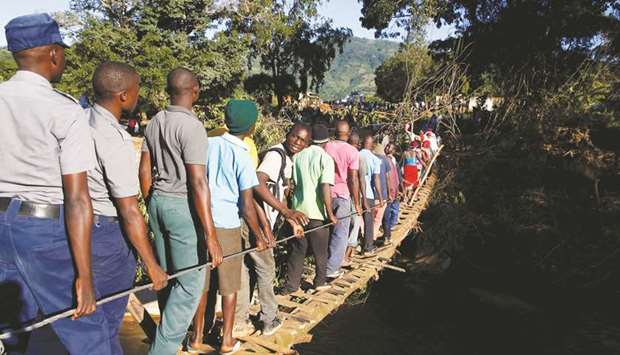Survivors of a cyclone that pummelled southern Africa began receiving medicine, food and tents yesterday as floodwaters receded, while officials warned up to 500,000 people are displaced in the storm-struck region.
Cyclone Idai smashed into Mozambique’s coast, unleashing hurricane-force wind and rain that flooded swathes of the poor country before battering eastern Zimbabwe – killing more than 700 people across the two countries according to estimates.
An area of roughly 3,125sq km is still under water and 3mn people across Mozambique, Zimbabwe and Malawi have been affected by the cyclone and its aftermath, according to the UN World Food Programme (WFP).
“Close to 500,000 have been displaced in the three countries,” the WFP said in a briefing note.
The head of the International Federation of Red Cross and Red Crescent Societies (IFRC) Elhadj As Sy warned on Monday “we are sitting on a ticking bomb” as he called for renewed efforts to address the worsening health situation.
As logistical conditions improved and roads to affected communities were being reconnected, the full scale of the humanitarian crisis was revealed for the first time since disaster hit on March 15.
Hundreds are still missing in Mozambique and Zimbabwe.
“The conditions for rescue are improving. Yesterday a road reopened which was really important to allow officials to work and rescue,” Mozambique’s Land Minister Celso Correa told reporters on Monday.
The UN Office for the Co-ordination of Humanitarian Affairs’ Sebastian Rhodes Stampa also said on Monday that 30 aid missions were flying in while others were going by road “so we can really deliver volume”.
“We are packing food and shelter now – they will go out both north and south,” he said.
In New York, UN aid chief Mark Lowcock launched an appeal to provide Mozambique with $282mn to help with relief efforts over the next three months.
Lowcock told reporters that similar campaigns would be instigated in the coming days for Zimbabwe and Malawi.
Buzi, one of Mozambique’s worst-hit towns located 30km southwest of the city of Beira, became reachable by road on Monday – for the first time since the storm hit.
“It will now be much faster to deliver aid,” Stampa added.
In Buzi, survivor Joao Zacaria said that “one man who had 40 cows lost them all. Forty, can you imagine!”
IFRC head Sy, who had just returned from the region, warned of a “high risk of water-borne diseases” like cholera and typhus – as well as malaria, which is endemic in the region.
The WHO has announced it is mobilising 900,000 doses of cholera vaccines from the global stockpile to help prevent an epidemic.
United Nations chief Antonio Guterres called the cyclone “yet another alarm bell about the dangers of climate change.”
Guterres described Idai as “an uncommonly fierce and prolonged storm.”
“At least 1mn children need urgent assistance and this number may well grow. We fear that whole villages have been washed away in places we have yet to reach,” Guterres told reporters at the United Nations.
There were reports that $1bn worth of infrastructure had been destroyed, he added.
While scientists say single weather events cannot be attributed to climate change, they say global warming is causing more extreme rainfall and storms, sweltering heatwaves, shrinking harvests and worsening water shortages around the world.

Survivors of cyclone Idai cross a temporary foot bridge to receive aid at Coppa business centre in Chipinge, Zimbabwe.

